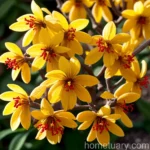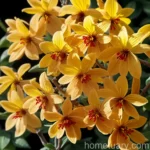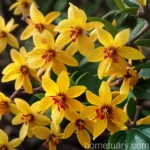Witch Hazel (Hamamelis x intermedia ‘Livia’): A Comprehensive Guide
Witch hazel (Hamamelis x intermedia ‘Livia’) is a captivating and versatile plant that has gained popularity for its stunning flowers, medicinal properties, and remarkable landscape value. This article aims to provide a thorough understanding of the witch hazel plant, covering its culture, uses, care requirements, propagation, common diseases and pests, and interesting botanist’s tips. Whether you are a seasoned gardener or a novice plant enthusiast, this comprehensive guide will equip you with the knowledge to cultivate and appreciate the beauty of witch hazel.
What is Witch Hazel (Hamamelis x intermedia ‘Livia’)?
Witch hazel (Hamamelis x intermedia ‘Livia’) is a deciduous shrub that belongs to the family Hamamelidaceae. It is a hybrid between Hamamelis japonica and Hamamelis mollis, renowned for its exquisite, spidery flowers that bloom in the late winter to early spring. The ‘Livia’ variety is particularly cherished for its abundant, fragrant blooms and vibrant autumn foliage, making it a prized addition to gardens and landscapes.
Key Takeaways – Witch Hazel (Hamamelis x intermedia ‘Livia’)
Before delving into the specifics of Hamamelis x intermedia ‘Livia’, let’s explore some key takeaways about this enchanting plant. This will provide a sneak peek into the diverse aspects of witch hazel, from its uses to its growth requirements.
- Witch hazel (Hamamelis x intermedia ‘Livia’) is a hybrid shrub known for its distinctive and fragrant flowers.
- The ‘Livia’ variety is revered for its abundant blooms and vibrant autumn foliage.
- This plant holds significance for its medicinal uses and is valued for its astringent properties.
- Witch hazel requires well-draining soil, moderate watering, and partial to full sunlight for optimum growth.
- Pruning, propagation, and disease resistance are important factors to consider when cultivating Hamamelis x intermedia ‘Livia’.
Now, we will delve into the various aspects of witch hazel (Hamamelis x intermedia ‘Livia’), including its culture, uses, care requirements, propagation, common diseases, and pests.
Culture
Understanding the cultural requirements of witch hazel is essential for successfully growing and nurturing this striking shrub. From its preferred sunlight conditions to its soil and water needs, a comprehensive grasp of its cultural preferences is crucial for fostering a healthy and thriving plant.
Water
Proper watering is fundamental to the well-being of witch hazel plants. While they are relatively low-maintenance once established, it is essential to ensure consistent moisture, especially during the drier periods. During the growing season, it is important to water the plant regularly, especially during prolonged dry spells, to maintain a slightly moist soil.
- Providing 1 to 2 inches of water per week during the growing season is generally sufficient to keep the root zone adequately moist.
- Mulching around the base of the plant can help retain soil moisture and regulate the soil temperature.
Sunlight
Witch hazel (Hamamelis x intermedia ‘Livia’) thrives in partial to full sunlight. When selecting a planting location, it is crucial to consider its sunlight requirements to ensure healthy growth and prolific flowering.
- Ideally, the plant should be positioned in a location where it receives at least 4-6 hours of direct sunlight per day.
- In hot climates, partial shade during the hottest part of the day can be beneficial to prevent leaf scorch and dehydration.
Fertilizer
Applying a balanced fertilizer can enhance the growth and blooming capacity of witch hazel plants. However, it is important to exercise restraint with fertilization, as excessive nutrients can lead to lush foliage at the expense of flowers.
- Applying a slow-release, balanced fertilizer in early spring, just before new growth appears, can promote healthy growth and abundant blooms.
- Excessive use of high-nitrogen fertilizers should be avoided, as it can result in excessive vegetative growth.
Soil
The soil composition and quality significantly influence the overall health and vigor of witch hazel plants. Well-draining, slightly acidic soils are preferred for optimal growth and performance.
- Witch hazel thrives in moderately rich, acidic to slightly acidic soils with a pH range of 5.5 to 6.5.
- It is important to ensure that the soil has good drainage to prevent waterlogging, which can lead to root rot and other issues.
Pruning
Pruning is an essential practice for maintaining the shape, health, and vigor of witch hazel plants. While they generally exhibit a naturally attractive form, periodic pruning can help manage their size and enhance flowering.
- Prune witch hazel immediately after flowering to shape the plant and remove any dead or damaged branches.
- Thinning out crowded or crossing branches can improve air circulation and reduce the risk of disease.
Propagation
Propagation of witch hazel can be achieved through various methods, including seed sowing, softwood cuttings, and layering. Each method has its own advantages and considerations, catering to different preferences and resources.
- Softwood cuttings taken in late spring or early summer have the highest success rate for propagating Hamamelis x intermedia ‘Livia’.
- Layering, where a low-growing branch is encouraged to root while still attached to the parent plant, can also be an effective method of propagation.
Container Popularity
Witch hazel can be successfully grown in containers, making it a popular choice for gardeners with limited space or those who wish to showcase its beauty on patios and balconies.
- When choosing a container, select one with sufficient drainage holes to prevent waterlogging and ensure good airflow to the roots.
- Use a high-quality, well-draining potting mix formulated for woody plants to provide an optimal growing medium for the witch hazel.
Container Care
Proper care and maintenance of witch hazel in containers are essential for ensuring its health and longevity. Here are some key considerations for container-grown witch hazel:
- Regular watering is essential, especially during the warmer months, to prevent the soil from drying out completely.
- Fertilize container-grown witch hazel sparingly, using a balanced, slow-release fertilizer to provide essential nutrients without promoting excessive growth.
Common Diseases
Witch hazel (Hamamelis x intermedia ‘Livia’) is generally resistant to most common diseases and pests. However, it is important to be aware of potential issues that can affect its health and vitality.
Disease Diagnosis
Understanding the symptoms and characteristics of common diseases that can impact witch hazel plants is crucial for prompt diagnosis and effective management.
- Leaf spots, powdery mildew, and phytophthora root rot are among the potential diseases that can affect witch hazel.
- Proper sanitation, adequate spacing between plants, and avoiding overhead irrigation can help prevent the onset and spread of diseases.
Common Pests
While witch hazel is relatively resistant to pests, there are a few common insects that can pose a threat to its health. Familiarizing oneself with these pests is essential for implementing appropriate pest management strategies.
- Aphids, scale insects, and spider mites are among the common pests that can infest witch hazel plants.
- Regular monitoring, maintaining good plant health, and using horticultural oils or insecticidal soaps can help manage pest infestations.
Botanist’s Tips
Glean insights and expert tips from botanists to maximize the health and beauty of Hamamelis x intermedia ‘Livia’:
- In regions with hot summers, providing some afternoon shade can prevent stress and leaf scorch.
- Witch hazel flowers can be delicately fragrant, and their distinctive appearance adds visual interest to the late winter landscape.
- Deadheading spent flowers can promote a more compact growth habit and redirect the plant’s energy towards new growth and flower production.
Fun Facts
Discover fascinating and intriguing facts about witch hazel that showcase its unique characteristics and attributes:
- Native American tribes used various parts of witch hazel for medicinal and ceremonial purposes.
- The bark and leaves of witch hazel are distilled to produce witch hazel water, a natural astringent and skin toner.
- The name “witch hazel” is believed to originate from the Middle English word “wych,” meaning “flexible,” as the branches were historically used for divining water sources, rather than having any connection to witchcraft.
Links to External Resources
Explore further resources and information about witch hazel (Hamamelis x intermedia ‘Livia’) from reputable sources:
- Royal Horticultural Society – Witch Hazel Cultivation
- University of Maryland Extension – Witch Hazel Fact Sheet
By delving into the myriad facets of Hamamelis x intermedia ‘Livia’, we’ve gained a deeper understanding of this remarkable plant. From its cultural requirements to its distinctive uses and pest management, the diverse dimensions of witch hazel make it a captivating subject for plant enthusiasts and horticulturists alike. As you embark on your journey to cultivate and appreciate witch hazel, may this comprehensive guide serve as a valuable resource to enhance your knowledge and appreciation of this enchanting shrub.















